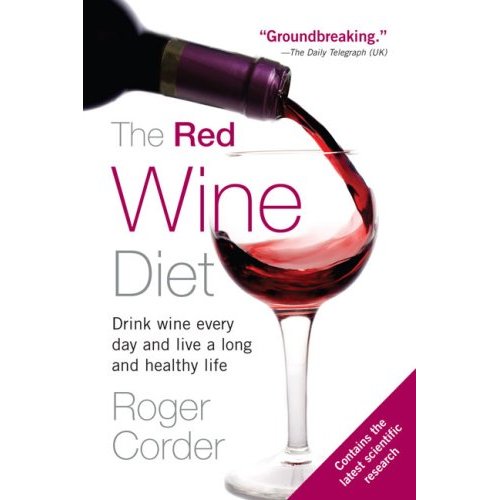The case in favor of healthful flavonoids seems to grow bit by bit.
Flavonoids such as procyanadins in wine and chocolate, catechins in tea, and those in walnuts, pomegranates, and pycnogenol (pine bark extract) are suspected to block oxidation of LDL (preventing its entry into plaque), normalize abnormal endothelial constriction, and yield platelet-blocking effects (preventing blood clots).
Dr. Roger Corder is a prolific author of many scientific papers detailing his research into the flavonoids of foods, but wine in particular. He summarizes his findings in a recent book, The Red Wine Diet. Contrary to the obvious vying-for-prime-time title, Dr. Corder's compilation is probably the best discussion of flavonoids in foods and wines that I've come across. Although it would have been more entertaining if peppered with more wit and humans interest, given the topic, its straightfoward, semi-academic telling of the story makes his points effectively.
Among the important observations Corder makes is that regions of the world with the greatest longevity also correspond to regions with the highest procyanidin flavonoids in their wines.

Regading the variable flavonoid content of various wines, he states:
Although differences in the amount of procyanidins in red wine clearly occur because of the grape variety and the vineyard environment, the winemaker holds the key to what ends up in the bottle. The most important aspect of the winemaking process for ensuring high procyanidins in red wines is the contact time between the liquid and the grape seeds during fermentation when the alcohol concentration reaches about 6 percent. Depending on the fermentation temperature, it may be two to three days or more before this extraction process starts. Grape skins float and seeds sink, so the number of times they are pushed down and stirred into the fermenting wine also increases extraction of procyanidins. Even so, extraction is a slow process and, after fermentation is complete, many red wines are left to macerate with their seeds and skins for days or even weeks in order to extract all the color, flavor, and tannins. Wines that have a contact time of less than seven days will have a relatively low level of procyanidins. Wines with a contact time of ten to fourteen days have decent levels, and those with contact times of three weeks or more have the highest.
He points out that deeply-colored reds are more likely to be richer in procyanidins; mass-produced wines that are usually "house-grade" served at bars and restaurants tend to be low. Some are close to zero.
Wines rich in procyanidins provide several-fold more, such that a single glass can provide the same purported health benefit as several glasses of a procyanidin-poor wine.
So how do various wines stack up in procyanidin content? Here's an abbreviated list from his book:
Australian --tend to be low, except for Australian Cabernet Sauvignon which is moderate.
Chile --only Cabernet Sauvignon stands out, then only moderate in content.
France --Where to start? The French, of course, are the perennial masters of wine, and prolonged contact with skins and seeds is usually taken for granted in many varieties of wine. Each wine region (French wines are generally designated by region, not by variety of grape) can also vary widely in flavonoid content. Nonetheless, Bordeaux rate moderately; Burgundy low to moderate (except the village of Pommard); Languedoc-Roussillon moderate to high (and many great bargains in my experience, since these producers live in the shadow of its norther Bordeaux neighbors); Rhone (Cote du Rhone) moderate to high, though beware of their powerful "barnyard" character upon opening; decanting is wise.
Italy --Much red Italian wine is made from the Sangiovese grape and called variously Chianti, Valpolicella, and "super-Tuscan" when blended with other varietals. Corder rates the southern Italian wines from Sicily, Sardinia, and the mainland as high in procyanidins; most northern varieties are moderate.
Spain --Moderate in general.
United States --Though his comments are disappointingly scanty on the U.S., he points out that Cabernet Sauvignon is the standout for procyanidin content. He mentions only the Napa/Sonoma regions, unfortunately. (I'd like to know how the San Diego-Temecula and Virginian wines fare, for instance.)
The winner in procyanidin content is a variety grown in the Gers region of southwest France, a region with superior longevity of its residents. The wines here are made with the tannat grape within the Madiran appellation; wines labeled "Madiran" must contain 40% or more tannat to be so labeled (such is a quirk of French wine regulation). However, among the producers Dr. Corder lists are Chateau de Sabazan, CHateau Saint-Go, Chateau du Bascou, Domaine Labranche Laffont, and Chateau d'Aydie. (A more complete can be found in his book.)
How does this all figure into the Track Your Plaque program? Can you succeed without red wine? Of course you can. I doubt you could do it, however, without some attention to flavonoid-rich food sources, whether they come from spinach, tea, chocolate, beets, pomegranates, or red wine.
Though my wife and I love wine, I confess that I've never personally drank or even seen a French Madiran wine. Any wine afficionados with some advice?